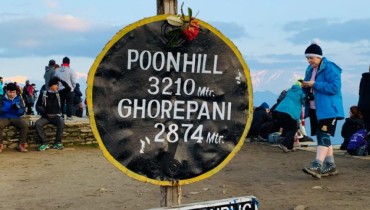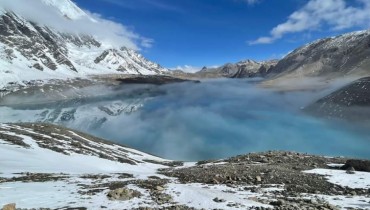Indra Jatra - A Festival in Kathmandu Valley

One of the most thrilling and revered celebrations of the Newar community of the Kathmandu Valley is the eight-day long Indra Jatra festival, which takes place in September. This also heralds the start of the month-long autumn festival season. The process starts with the construction of a pine wood pole in Basantapur Square in front of the former Hanuman Dhoka Palace.
Hundreds of onlookers assemble in Palace Square and on the nearby temples for the pole-raising event. Through Kathmandu's main thoroughfares, the chariot of the Living Goddess Kumari is paraded.
Nearly every evening, masked dancers known as Lakhay perform in the streets to the accompaniment of loud drums. The celebration honors the day when Indra descended from heaven in human form to search for a herb.
During Indra Jatra, oil wicks are used to illuminate the shrines and historic palace structures near Kathmandu Durbar Square. On the platform in front of the Living Goddess (Kumari) temple, a performance symbolizing Lord Vishnu's ten terrestrial incarnations is performed every night. At Indra Chowk, the enormous representation of Akash Bhairab's head is placed on public display in front of his temple.
Ecstatic crowds congregate near Hanuman Dhoka Palace in the afternoon of the day before the full moon to see the long-awaited Living Goddess' chariot procession and catch a glimpse of the revered young Newar girl who has been deified as Kumari, or Goddess Taleju, in person.
People congregate in the tiny alleyways of the old Kathmandu to witness and pay reverence as the chariot of the Kumari is pulled by two other, smaller chariots pulling a representative of Ganesh and Bhairav. The lowering of the pole (Lingo) holding Indra's flag during religious rituals marks the conclusion of the Indra Jatra celebration.
Below, you can find the daily activities of Indra Jatra:
Day 1 - At Kathmandu Durbar Square, the Yasin or linga, a pole from which the banner of Indra is flown, is constructed to mark the beginning of the festival. Upku Wanegu which takes place on the first day, is another activity in which participants pay respect to departed family members by visiting shrines while carrying lit incense. On the way, they also set up a few tiny butter lamps. Some perform the tour while singing hymns. The winding route travels around the outside edges of the city's historic district. Additionally, a number of masked dancers dressed as various gods and goddesses are brought out for this event, which is significant in its own right.
Day 2 - The masked dancers tour several neighborhoods in Kathmandu on this day to bless the inhabitants. Additionally, during the day, worshippers offer sacrifices to Akash Bhairab at Layakuli, Swet Bhairab, and Indra at Maru tole.
Day 3 - On this day, the chariot of the Kumari is brought to the south side of the old Kathmandu, followed by two other smaller chariots bearing a representative of Ganesh and Bhairav. This journey takes roughly 4-5 hours, during which the chariot is accompanied by numerous masked dancers and ethnic music (Dhime Baja). Indra's mother Da-gi searches for her son Indra after the chariot pulling is finished at Basantapur Durbar Square. Indra had traveled to earth to gather a flower called a "parijat" for his mother Da-gi. Throughout the year, sons and spouses of the deceased follow Da-gi in the hope of joining him in paradise to be with their loved ones. Following the path of da-gi, a group of oil lamps called "bau-mata" are carried about the town, ostensibly to provide da-gi with light as she travels.
Day 4 - The three live deities journey to the northern region of the ancient Kathmandu on each chariot, and then return to Layakuli in the evening. Lakhe, Pulu Kishi, and Sava-Bhaku, three masked dancers, guide the three chariots as they move forward. Offerings are still being made to the gods on display. People worship Indra in the evening by lighting an oil lamp called a "dal-lu," thanking him for the rains that have been provided for rice plantations, and pleading with him to stop the rains because the rice crops no longer need them. Devotees then eat "samayabaji," a dish blessed by the gods that include flattened and puffed rice, grilled meat (chyoala), roasted black soybeans, and pieces of ginger.
Day 5 - Lakhe and Pulu Kishi dance performances continue into the evening after beginning in the afternoon. The worshippers continue to make sacrifices to the deities on display at Layakuli, Indra Chok, and Maru tole throughout the day and into the night.
Day 6 and day 7 - Lakhe and Pulu Kishi dances continue.
Day 8 - Following their journey to Kilagal, the chariots of Kumari, Ganesh, and Batuk Bhairava return to Basantapur Durbar Square. Dancers from Lakhe and Pulu Kishi perform in front of the chariots. At the Kumari House, the Living Goddess Kumari bestows the "tika" blessing, which gives the head of state the authority to rule the country for a full year. The gods on display all return to their own shrines for one more year. On the first day of the festival, the golden Indra that was placed at the base of the Indradhoj is taken and stored. The Indra Jatra comes to a conclusion when the Indradhoj is hauled down and the pole is dragged to the bank of the Vishnumati River and torched there.
Dream Big! Dream Travel!!
Quick Inquiry

Why Nepal is best trekking destination?

5 reasons to visit Nepal in 2020


